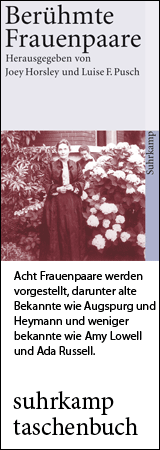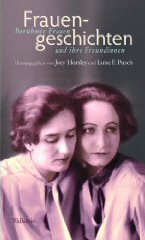
Born 6 February 1905 in Berlin
Died 5 May 1982 in Cologne
German Author
115th birthday on 6 February 2020
Biography • Weblinks • Literature & Sources
Biography
Her own biography is as gripping a read as her seven novels, which offer a unique, psychologically astute and ironic view of “German reality” (Klaus Mann) from the end of the first world war to the post WW II era. And she herself must have often been as courageous and bold as her young women protagonists, although far less naïve.
The daughter of well-off, liberal parents, Irmgard Keun grew up in Berlin and Cologne, cities which would later be unmistakably recognizable in her novels through the perfectly captured spoken idiom of her characters and the many visual details. Following a brief acting career, Keun became famous almost overnight with her first novel, Gilgi, eine von uns (Gilgi, One of Us, 1931). In the first year it reached an edition of 30,000 copies. Her second, Das kunstseidene Mädchen (The Artificial Silk Girl, 1932), was almost as successful. Both novels feature young women who long to rise above their lower middle-class origins and define themselves in the spirit of the Weimar era New Woman as independent, even though this reveals itself to be quite difficult, precisely in the early 1930s.
Keun experienced similar challenges herself once the Nazis had come to power and her books were banned. It was typical of her daredevil boldness that she attempted to reclaim her lost earnings through a lawsuit against the government; she succeeded only in drawing the attention of the Gestapo to herself. In 1936 she went into exile in Ostende, Belgium. Her husband Johannes Tralow, a writer 27 years her senior, remained in Germany, while her secret lover, the Jewish doctor Arnold Strauss, waited for her in America. For a year and a half Keun was the partner of Austrian author Joseph Roth, with whom she travelled across Europe – both of them under constant stress for lack of money or the right visas.
In this difficult time she nevertheless produced three novels, in which she processed her experiences in Nazi Germany (Nach Mitternacht, After Midnight, 1937) or in exile (D-Zug dritter Klasse/Third Class Express; Kind aller Länder/Child of All Nations 1938). Once again it is the seemingly naïve perspective of a young girl or woman that gives the narrative its unique tone and refreshing directness.
Following her separation from Roth and a visit to Strauss in Virginia Beach, USA, Keun found herself in 1940 in Amsterdam without money or a passport, as the Germans invaded the Netherlands. She was able to escape this situation by persuading an officer of the SS to provide her with a fake passport so that she could return to Germany, where she lived out the rest of the war in illegal anonymity.
After the war Keun attempted a comeback with feuilletons and a novel (Ferdinand, der Mann mit dem freundlichen Herzen, Ferdinand, the Kind-hearted Man, 1950). And a radio version of her teenage narrative Das Mädchen, mit dem die Kinder nicht verkehren durften (translated in the UK as Grown-ups Don't Understand and in the US as The Bad Example), originally published in exile in 1936, gained temporary popularity. But in general she did not catch on with readers of the conservative postwar era, and she gradually grew silent.
Keun had a daughter in 1951; she never revealed the identity of the father. Increasingly, longstanding problems with alcohol intensified, and she was twice institutionalized, the second time for six years (1966-72). Behavioral patterns further suggest that she may have suffered from manic-depressive disease. Keun’s rediscovery began in the 1970s, in part because of the enhanced interest in women writers, as well as because of renewed interest in the Weimar period. Her works were reprinted, and one year before her death she was awarded the first Marieluise-Fleißer-Preis of the city of Ingolstadt.
Author: Joey Horsley
Links
Rolf Löchel über Keun zum 100. Geburtstag
Sonja Hilzinger über Keun zum 105. Geburtstag
Links geprüft am 1. Februar 2020 (AN)
Literature & Sources
Arend, Stefanie, Ariane Martin (Hrsgg.). 2005. Irmgard Keun 1905/2005. Deutungen und Dokumente. Aisthesis Verlag, Bielefeld 2005, ISBN 3-89528-478-5.
Bescansa, Carmen. 2007. Gender- und Machttransgression im Romanwerk Irmgard Keuns. (Mannheimer Studien zur Literatur- und Kulturwissenschaft; Bd. 42). Röhrig Verlag, St. Ingbert 2007, ISBN 978-3-86110-424-7.
Beutel, Heike, Anna Barbara Hagin (Hrsg.). 1995. Irmgard Keun. Zeitzeugen, Bilder und Dokumente erzählen. Emons, Köln 1995, ISBN 3-924491-48-8.
Häntzschel, Hiltrud. 2001. Irmgard Keun. Rororo Monographie. Reinbek bei Hamburg. Rowohlt TB.
Horsley, Ritta Jo [Joey]. 1990. “'Warum habe ich keine Worte? . . . kein Wort trifft zutiefst hinein.': The Problematics of Language in the Early Novels of Irmgard Keun”. Colloquia Germanica 23, 3-4 (1990): 297-313.
Horsley, Ritta Jo [Joey]. 1993. “Witness, Critic, Victim: Irmgard Keun and the Years of National Socialism”, in Gender, Patriarchy and Fascism in the Third Reich: The Response of Women Writers. Hg. Elaine Martin. Detroit, MI. Wayne State Press. 65-117.
Horsley, Ritta Jo [Joey]. 1998. “Irmgard Keun”, Women Writers in German-Speaking Countries: A Bio-bibliographical Critical Sourcebook. Hg. Elke Fredriksen & Elizabeth Ametsbichler. Westport, CT; London. Greenwood. 233-43.
Horsley, Ritta Jo [Joey]. 2000. “'This Number is Not in Service': Destabilizing Identities in Irmgard Keun's Novels from Weimar and Exile.” In Facing Fascism and Confronting the Past: German Women Writers from Weimar to the Present.Hg. Elke Frederiksen & Martha Wallach. Albany, NY. SUNY. S. 37-60.
Horsley, Ritta Jo. 1988. “Irmgard Keun”, in: Dictionary of Literary Biography. Vol 69. [Contemporary German Prose Fiction: 1945 to the Present]. Hg. Wolfgang D. Elfe & James Hardin. Detroit. Gale Research Company.
Horsley, Ritta Jo. 1992. “Irmgard Keun (1905-1982): 'Auf dem Trittbrett eines rasenden Zuges' - Irmgard Keun zwischen Wahn und Wirklichkeit”, in Duda, Sibylle & Luise F. Pusch. Hg. 1992. WahnsinnsFrauen. Frankfurt/M. suhrkamp TB 1876. S. 280-308.
„Irmgard Keun.“ Wikipedia
Keun, Irmgard. 2017. Irmgard Keun. Das Werk. Mit einem Essay von Ursula Krechel. Hrsg. i. A. der Deutschen Akademie für Sprache und Dichtung und der Wüstenrot Stiftung von Heinrich Detering und Beate Kennedy. Wallstein, Göttingen 2017, ISBN 978-3-8353-1781-9.
Keun, Irmgard. 1988. Ich lebe in einem wilden Wirbel: Briefe an Arnold Strauss, 1933-1947. Hg. Gabriele Kreis und Marjory S. Strauss. Düsseldorf. Claassen.
Keun, Irmgard.1983 (1954). Wenn wir alle gut wären: Kleine Begebenheiten, Erinnerungen und Geschichten. Hg. Wilhelm Unger. Köln. Kiepenheuer & Witsch.
Krechel, Ursula. 1979. “Irmgard Keun: Die Zerstörung der kalten Ordnung: Auch ein Versuch über das Vergessen weiblicher Kulturleistungen.” Literaturmagazin 10: 103-128.
Kreis, Gabriele. 1993 [1991]. “Was man glaubt, gibt es”: Das Leben der Irmgard Keun. München. Heyne TB.
Marchlewitz, Ingrid. 1999 Irmgard Keun. Leben und Werk. Königshausen & Neumann, Würzburg 1999, ISBN 3-8260-1621-1.
Schüller, Liane. 2005. Vom Ernst der Zerstreuung. Schreibende Frauen am Ende der Weimarer Republik: Marieluise Fleißer, Irmgard Keun und Gabriele Tergit. Aisthesis Verlag, Bielefeld 2005, ISBN 3-89528-506-4.
Steinbach, Dietrich. 1985. “Irmgard Keun”, Kritisches Lexikon zur deutschsprachigen Gegenwartsliteratur. Hg. Heinz Ludwig Arnold. München. Edition text + kritik. S. 1-11.
Weidermann, Volker. 2008 : Das Buch der verbrannten Bücher. Köln: Verlag Kiepenheuer & Witsch, 2008; ISBN 978-3-462-03962-7. (Zu Keun Seite 188-191)
If you hold the rights to one or more of the images on this page and object to its/their appearance here, please contact Fembio.



